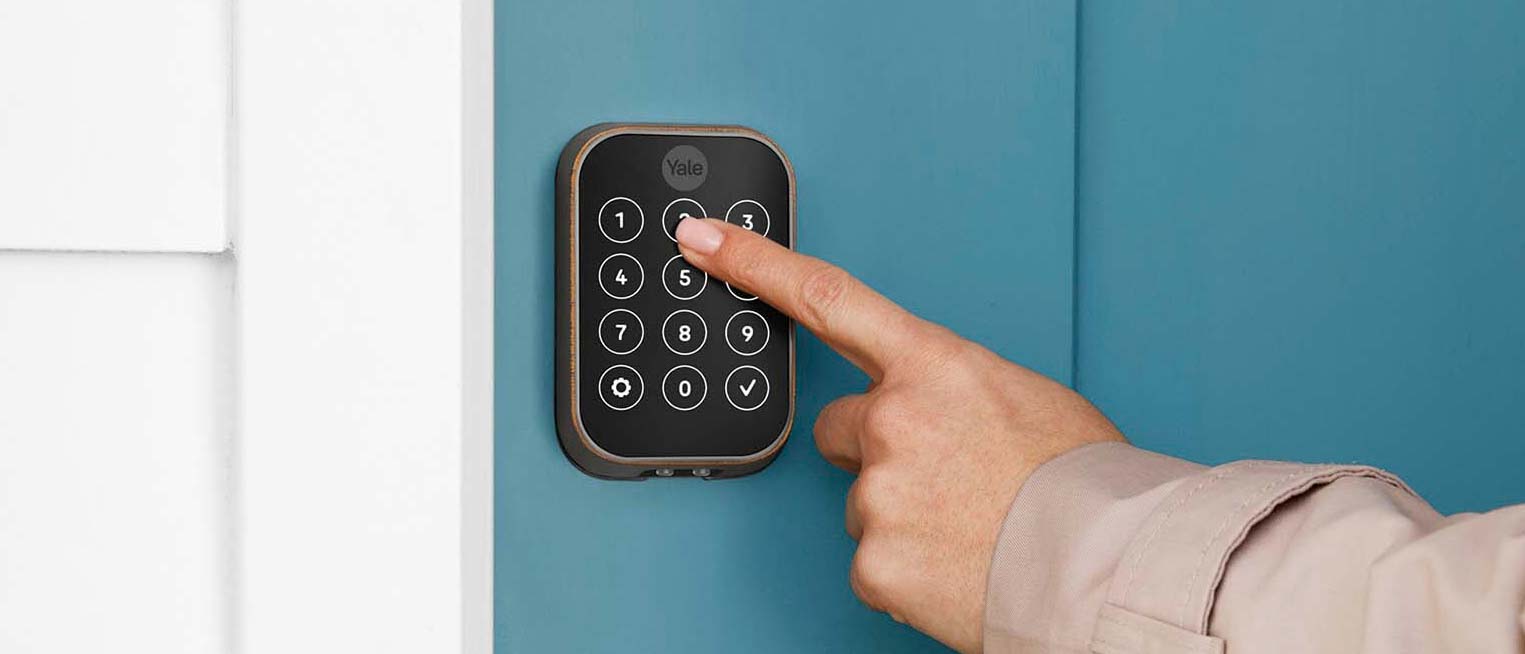Tom's Guide Verdict
The Yale Assure Lock 2 is a very well-rounded and attractive smart lock, though it lacks some features found on competing models, such as tap-entry and fingerprint identification.
Pros
- +
Works with Alexa, Google Home, and HomeKit
- +
Matter-compatible
- +
Attractive design
Cons
- -
Have to tap Yale logo to activate lock
Why you can trust Tom's Guide
Lock type: Deadbolt
Works with: Alexa, Google Home, Homekit, SmartThings
Wireless: Bluetooth, Wi-Fi
Number Pad: Yes
Alarm: No
Codes: 250
ANSI/BHMA rating: Commercial Grade 2
Batteries: Four AA
The Yale Assure Lock 2 is a modest upgrade over its predecessor, the Yale Assure Lock SL. Both have the same subdued and stylish number pad, use the same easy-to-use app, and great integration with all of the top smart home systems.
On the inside, the Assure Lock 2 is about 30% smaller than the original, and also uses interchangeable modules if you want to connect it to Wi-Fi, Zigbee, Z-Wave — and yes, Matter, which is coming soon. However, in our Yale Assure Lock 2 review, we found it lacked a few things found on competing models among the best smart locks.
Yale Assure Lock 2 review: Price and availability
The Yale Assure Lock 2 review first went on sale in the fall of 2022, and is available in several configurations. For starters, you can opt for either a touchscreen or a keypad with physical buttons; you can also choose between keyed and keyless options — the former has a traditional keyhole below the number pad, while the latter doesn’t. Touchscreen models cost $179, while keypad models are $159. There’s no change in price for keyed or keyless models.
The Assure Lock 2 has Bluetooth built in, but you can purchase it with the Wi-Fi module for $239 for the keypad version and $259 for the touchscreen version. This module lets you connect the lock directly to your home network, without needing a smart home hub like the HomePod Mini. You can also purchase the Wi-Fi module separately for $79. (Other modules for Z-Wave and Matter are also available).
Yale Assure Lock 2 review: Design
The Yale Assure Lock 2 has a similar setup to most other smart locks: On the exterior of your door is a number pad, which may or may not include a keyhole depending on the model you purchase. The key-free version I tested is attractive and minimalist, with a matte finish that resists fingerprints.

My review model came in a satin nickel finish, but you can also choose black suede and bronze. Sadly, there’s no polished brass option, so those with older door hardware — like me — may find that the Yale lock doesn’t match.
On the inside of your door is the larger half of the lock — although here, it’s 30% smaller than the original Assure Lock. The lower half of the lock holds the throw to manually lock and unlock the door. The top half of this part has a black plastic cover that pops off to reveal the battery compartment as well as the lock’s wireless module.

In all, it’s a good looking lock that won’t take up too much space on your door, inside or out.
Yale Assure Lock 2 review: Installation
Installing the Assure Lock 2 was a fairly simple process. After removing my original lock, I then attached both the outward-facing and inward-facing parts of the lock, as well as the deadbolt itself. Yale includes paper templates to help you make sure that the size of the holes in your door and your doorframe are the correct size and placement. Yale’s app also walks you through each step with short videos. The lock also comes with a small Doorsense module, which can be mounted within the doorframe or on the side; the module tells the lock whether the door is closed or ajar. In all, it took me about 30 minutes to install and get the lock up and running.

As part of the installation process, you also set up an access code on the keypad; like the original Assure Lock SL, the Assure Lock 2 can only hold 250 codes.
The Assure Lock is powered by four AA batteries; should they run out of juice, you can hold a 9-volt battery to the bottom of the exterior portion of the lock to temporarily power it, so you can get back in your house.
Yale Assure Lock 2 review: Performance
The lock’s number pad lit up instantly and responded just as quickly to my inputs. The throw on the inside was solid and smooth. While the matte number pad is coated to prevent your fingerprints from leaving a mark, I wish it also had a security feature like the Kwikset Halo, which requires you to press two random digits before entering your code. However, in order to activate the pad’s backlighting, you have to first press the Yale logo at the top — something that might not be obvious, even to those who have used smart locks before.
Of course, you don’t have to press any button at all. By enabling the auto-unlock feature in the Yale app, the lock will automatically open once your phone gets within Bluetooth range. I found that it worked well — once I was around 10-15 feet away from the door, the lock automatically opened — but it does make me a little uneasy that there’s no secondary authentication needed to unlock your door. You can increase and decrease the radius around which the lock will activate or deactivate, though. You’ll also want to make sure that auto-lock is also turned on in the app, so that the door bolts itself shut.

You can lock and unlock the Assure Lock 2 using the app on your Apple Watch, but unlike the Schlage Encode Plus, it’s not a simple tap-to-unlock; you have to press a button on the watch itself. Not as magical.
Yale Assure Lock 2 review: App and smart home
Because both Yale and August are owned by the same company, you can use either the Yale Access app or the August app to control the lock. Each app is identical; the main screen has a large red circle to indicate your lock is closed, and a green circle when it’s open.

In the app, you can add guests, who can be given permission to access the app or simply be given a code to lock and unlock the door. However, these settings and others can only be accessed when you’re connected to the lock via Bluetooth, a good precaution against would-be hackers.
The app also lets you connect the lock with Airbnb, Alexa, HomeKit, Google Home, IFTTT, and Philips Hue. Samsung SmartThings compatibility is on the roadmap, as is Matter. The one integration I wish it had, though, was with Ring; the Schlage Encode smart lock can be controlled from within the Ring app, so if you see someone at your door, you can let them in without having to jump from one app to another.
As mentioned earlier, the Assure Lock 2 has interchangeable modules for Wi-Fi, Zigbee, Z-wave, and coming soon, Matter. These modules, which are sold separately, let you connect the lock to those respective smart home networks. The Wi-Fi module will most likely appeal to those with the least experience in smart home, but it will chew up the batteries in the lock a lot faster than the alternatives.
Yale Assure Lock 2 review: Verdict
The Yale Assure Lock 2 is a solid follow-up to the company’s original. It’s smaller than the original, just as sleek, it’s easy to use, and it works with every major smart home platform, which is why it earned a place on our list of the best smart locks. I wish it had a fingerprint reader or some other method to obscure my passcode, but otherwise I found it worked well.
While it does work well with the Apple Watch, we did prefer the more seamless experience we had with the Schlage Encode Plus, but both locks are great in their own right.
When shopping for one of the best smart locks, the Yale Assure 2 should definitely be on your short list.

Michael A. Prospero is the U.S. Editor-in-Chief for Tom’s Guide. He oversees all evergreen content and oversees the Homes, Smart Home, and Fitness/Wearables categories for the site. In his spare time, he also tests out the latest drones, electric scooters, and smart home gadgets, such as video doorbells. Before his tenure at Tom's Guide, he was the Reviews Editor for Laptop Magazine, a reporter at Fast Company, the Times of Trenton, and, many eons back, an intern at George magazine. He received his undergraduate degree from Boston College, where he worked on the campus newspaper The Heights, and then attended the Columbia University school of Journalism. When he’s not testing out the latest running watch, electric scooter, or skiing or training for a marathon, he’s probably using the latest sous vide machine, smoker, or pizza oven, to the delight — or chagrin — of his family.

